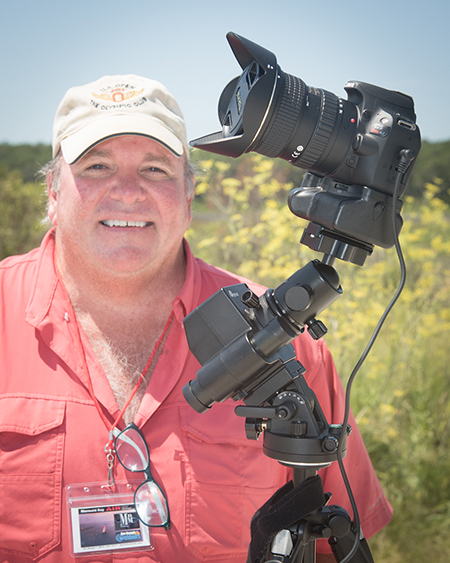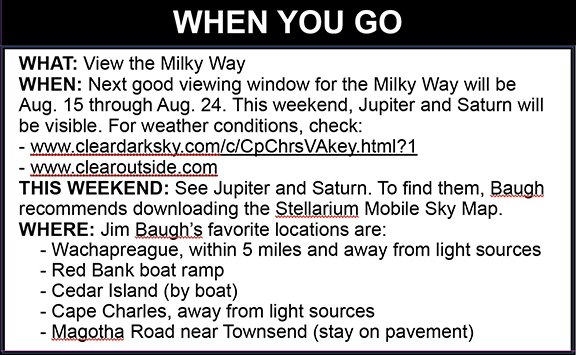
By Jim Ritch —
A remote location surrounded by water grants Eastern Shore stargazers an excellent location for viewing the Milky Way.
The light pollution of Virginia Beach, Va., and Ocean City, Md., fades away. The ocean to our east projects nothing more than an occasional celestial reflection, a visual accent to the sweeping slash of stars that angles across our skies.
The Milky Way, essentially a sideways view through more than 200 billion stars in our galaxy, stretches across most of the southeastern sky, providing a faint backdrop to brighter but smaller constellations.
Videographer and producer Jim Baugh, of Cape Charles, owner and producer of Jim Baugh Outdoors TV, mastered the art of forecasting the best viewing to indulge a childhood

fascination for celestial navigation. Eventually, this side project for his business evolved into a four-minute compilation of time-lapse sky views that show the Milky Way rising from the horizon and angling up and across the sky until dawn.
The film, which made its debut last year at Cape Charles’ Palace Theatre during the Experimental Film Virginia festival, has won four awards, including best in the experimental film category in the Madras Independent Film Festival in India. Entitled “The Milky Way Galaxy, Our Home,” the film was recently entered for consideration at the internationally known Sundance Film Festival.
The film includes an original score written by Baugh and will motivate stargazers and their children for the late-night adventure ahead. View the film on his blog at https://jimbaughoutdoors.blogspot.com/2019/03/milky-way-madness-2019.html
Baugh admits that the Milky Way can be elusive, requiring the right combination of location, weather, and grit. In the four last months, he has found only four nights for ideal viewing and, in his case, astrophotography.
Choose Your Ideal Location
Baugh has four favorite locations on the Shore.
The two with the darkest sky and public access are the town of Wachapreague and the Red Bank boat ramp. Wachapreague is so good for viewing that any location with an unobstructed view of the sky within about five miles of town works well, Baugh said.
Town residents hope to capitalize on their star-filled skies by registering as an official “dark sky” site and marketing the town to stargazers.
For the ultimate viewing experience, even better than Wachapreague, is unpopulated Cedar Island, a barrier island separated from Wachapreague by four miles of marsh.
Getting there requires a boat, however. Captain Meriwether Payne, owner of Seaside Ecotours in Wachapreague, is among the charter skippers who can carry visitors to the island.
Baugh’s other favorite sites include Cape Charles locations removed from the street lights of the business district.
On the ocean side of the peninsula, he also likes to shoot from Magotha Road, south of Townsend. Although the small beach at the road’s end is privately leased, the paved portion of the road is open to the public.
Find a Clear Night
For the best viewing, try to schedule around the phases of the moon, which can be bright enough to obscure the Milky Way.
Stargazers want to wait for the five days before and after a new moon, when the visible part of the moon disappears or shrinks to just a sliver, Baugh said.
This month, that prime viewing period will begin roughly Aug. 15 and continue until about Aug. 24, bookending an Aug. 18 new moon.
Fortunately, two websites juggle data on the moon and the weather, producing location-specific forecasts for viewing, Baugh said.
One of those sites even made changes at Baugh’s request. The owner and programmer of the website www.cleardarksky.com created a special webpage that forecasts cloud cover, humidity, and other viewing conditions for Cape Charles. To use the forecasts, which Baugh says have been quite accurate, follow this link: http://www.cleardarksky.com/c/CpChrsVAkey.html?1
In the four top rows of colored rectangles that signify viewing variables, look for columns containing four dark blue rectangles. These columns indicate ideal combinations of what astronomers call darkness, seeing, cloud cover, and transparency.
An additional lower three rows of rectangles indicate ground conditions — in other words, how comfortable the night may be for viewing.
Another site, www.clearoutside.com, provides a longer range forecast and additional details, including the phases of the moon.
This Weekend’s Forecast
The Milky Way will appear faintly against the bright light of the moon, which will reach its fullest size Monday. However, other celestial attractions, including Jupiter, Saturn, and the International Space Station, will be visible this weekend. To find them, Baugh recommends downloading Stellarium Mobile Sky Map ($3.49 on Google Play; $2.99, Apple App Store, $9.99 for premium).



